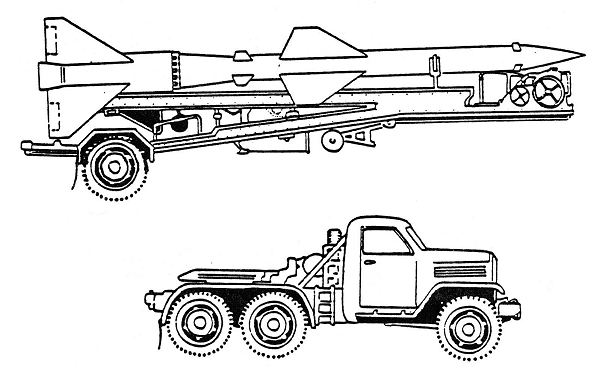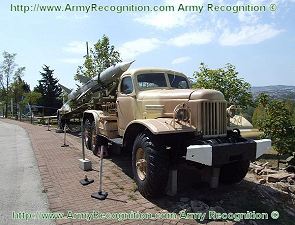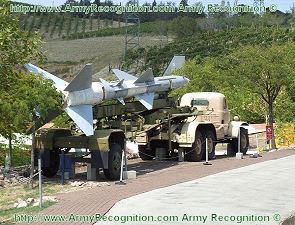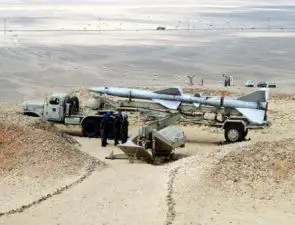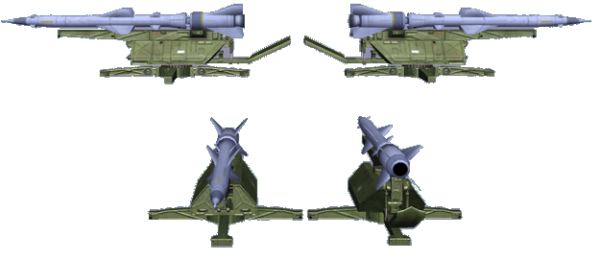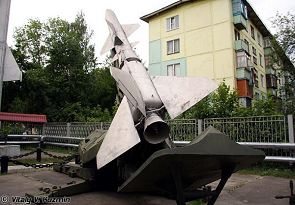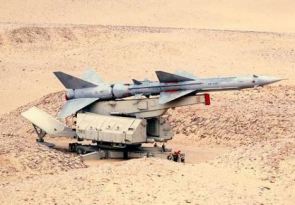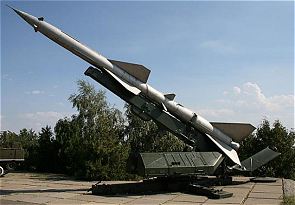|
| |
|
|
| |
| Description |
|
The SA-2 Guideline (Russian denomination S-75 ) is a low- to high-altitude , command guided, surface-to-air missile (SAM) system. Since its first deployment in 1957, it has become the most widely-deployed and -used air defense missile in history. The SA-2 Guideline was designed for the defense of both fixed targets and field forces. The V-75 was designed to cope with the threat posed by small groups of aircraft rather than massed raids. Flexibility and mobility are its chief advantages over the SA-1. In contrast to the massive SA-1 sites, each of which is capable of defending only a limited sector around the target area, each SA-2 site is capable of 360° coverage.
|
| |
|
Variants :
|
| |
|
System
|
Rocket
|
Nato Code
|
Launcher
|
Radar
|
|
SA-75 Dvina
|
V-750
|
SA-2 Guideline
|
SM-63
|
Fan Song A
|
|
SA-75M Dvina
|
V-750V
|
SA-2b Guideline Mode 1
|
SM-63-I
|
Fan Song B
|
|
S-75 Desna
|
V-750VN
|
SA-2c Guideline Mod 2
|
SM-63-I
|
Fan Song C
|
|
S-75D Desna
|
V-750VN
|
No code
|
SM-63-II
|
Fan Song C
|
|
S-75M Volchov
|
V-755
|
SA-2d Guideline Mod 3
|
SM-90
|
Fan Song E
|
|
S-75 Volchov
|
V-760
|
SA-2e Guideline Mod 4
|
SM-90
|
Fan Song E
|
|
S-75m2
|
V-759
|
SA-2f Guideline Mod 5
|
SM-90
|
Fan Song F
|
|
M-2M Volchov
|
V-753
|
SA-N-2 Guideline
|
SM-64
|
?
|
|
|
| |
|
|
| |
| Back to top |
| Launcher unit |
|
The V-75 system is designed to be simple and easy to operate with the minimum of specialized training. The standard deployment pattern of a battalion site consists of six semi-fixed trainable single rail launchers are deployed in the familiar hexagon arrangement about 60-100 meters apart. Although there are a variety of arrangement patterns, all sites consist of six launching positions -- usually revetted - deployed around a guidance radar and linked by service roads to facilitate loading. While the sites were permanent installations, all operating components of the system are mounted on wheeled vehicles and are capable of movement by road or raiL
|
| Missile |
|
The missile itself has a storable, liquid fuel, sustainer rocket motor, which uses an inhibited red fuming nitric acid/kerosene fuel mix. Towards the mid-section is a set of four cropped delta-shaped wings with a second in-line set of small fixed fins at the nose and a third in-line set of slightly larger powered control fins at the tail. The warhead of the SA-2a/b/c/d/f weighs 195 kg (90 kg of which is HE) and is a HE internally grooved fragmentation type with proximity, contact and command-type fuzing available. The 295-kg nuclear warhead for the SA-2e variant is believed to have a yield of 15 Kt. The conventional warhead weighs the same. The warhead of the SA-2a/b/c/e/f models is fitted forward of the main fins and behind the nose-mounted guidance assembly. Maximum blast radius against a high-altitude target such as a U-2 is around 244 m due to the rarefied atmosphere. At medium to low levels against fighter-sized targets the kill radius is about 65 m and the blast radius for severe damage is 100 to 120 m. The weapon has a CEP figure of 75 m with the large blast radius compensating for any system inaccuracies.
|
| Command and control radar |
|
In the center of launcher area of S-75 missile is installed the battery command post with the fire-control team and its computer, the RSN-75 (`Fan Song') missile control radar, the P-12 (NATO designation `Spoon Rest-A' truck-mounted or `Spoon Rest-B') early warning radar and usually six reload rounds on their articulated trailers. Again, the fire-control team, its equipment and the radars can either be van-mounted above ground, simply dug in or located underground in hardened concrete bunkers. The battalion's early warning and target acquisition P-12/`Spoon Rest' A-band radar has a range of 275-km using a large Yagi antenna array. At regimental HQ there is a fourth P-12/`Spoon Rest', a van-mounted Flat-Face (Russian denomination P-15) 250 km range C-band search and tracking radar with two elliptical parabolic reflectors and a Side Net (Russian denomination PRV-11) 180 km range E-band nodding height-finder radar mounted on a box-bodied trailer. There is also a radar control truck and a `Mercury Grass' truck-mounted command communications system for linking the HQ to the three battalions.
|
| Combat use |
|
Typically, the S-75 is organized into a regimental structure with three subordinate battalions. The regimental headquarters will control the early-warning radars and coordinate battalion actions. The battalions will contain several batteries with their associated acquisition and targeting radars. Each battalion will typically have six, semi-fixed, single-rail launchers for their V-750 missiles positioned approximately 60 to 100 m apart from each other in a hexagonal "flower" pattern, with radars and guidance systems placed in the center. It was this unique "flower" shape that led to the sites being easily recognizable in reconnaissance photos. Typically another six missiles are stored on tractor-trailers near the center of the site. The guidance system at an SA-2 site can handle only one target at a time, but can direct three missiles against a target simultaneously. Additional missiles could be fired against the same target after one or more missiles of the first salvo had completed their run.
|
| |
| Specifications |
|
|
| |
|
Type of missile
|
|
Low to high altitude missile
|
|
Country users
|
|
Afghanistan, Albania, Angola, Armenia, Belarus, Bosnia-Herzegovina, Bulgaria, China, Cuba, Czech Republic, Egypt, Ethiopia, Georgia, Hungary, India, Iran, Iraq, Kazakhstan, Kyrgyzstan, North Korea, Libya, Mozambique, Pakistan, Peru, Poland, Romania, Russia, Slovakia, Sudan, Syria, Tajikistan, Turkmenistan, Ukraine, Uzbekistan, Vietnam, Yemen
a
a
a
|
|
Guidance
|
|
Radio control
|
|
Warhead
|
|
(SA-2a/b/c/d/f) 195 kg (90 kg explosive) HE fragmentation with proximity and/or command fuzing systems
(SA-2e) optional 295 kg HE fragmentation with proximity and/or command fuzing or 15 kT nuclear warhead with command fuzing system
|
|
Launcher
|
|
single rail semi-fixed trainable
a
a
|
|
|
Accuracy
|
|
65 m
|
|
Effective range and altitude
|
|
Range:
(SA-2a) 8,000 m - 30,000 m
(SA-2b) 10,000 m - 34,000 m
(SA-2c) 9,300 m - 43,000 m
(SA-2d/e) 7,000 m - 43,000 m
(SA-2f) 6,000 m - 58,000 m
Altitude:
SA-2a) 3,000 m - 22,000 m
(SA-2b) 500 m - 30,000 m
(SA-2c/d/e) 400 m - 30,000 m
(SA-2f) 100 m - 30,000 m
|
|
Reload time
|
|
12 min
|
|
Radar
|
|
Spoon Rest: warning radar 275 km
Fan Song: acquisition radar
Flat Face: long-range C-band radar
Side Net: finder radar
a
a
|
|
Dimensions (Length)
|
|
(SA-2a) 10.6 m
(SA-2b/c/e/f) 10.8 m
(SA-2d) 11.2 m
|
|
|
| |
| Details view |
| Back to top |
| |
|
SA-Guideline S-75 ground-to-air missile mounted on truck for movement
|
|
|
| |
|
|
|
|
|
|
SA-Guideline S-75 ground-to-air missile sytem on ground base for firing position
|
|
|
| |
|
|
| |
|
|
|
|
|




























